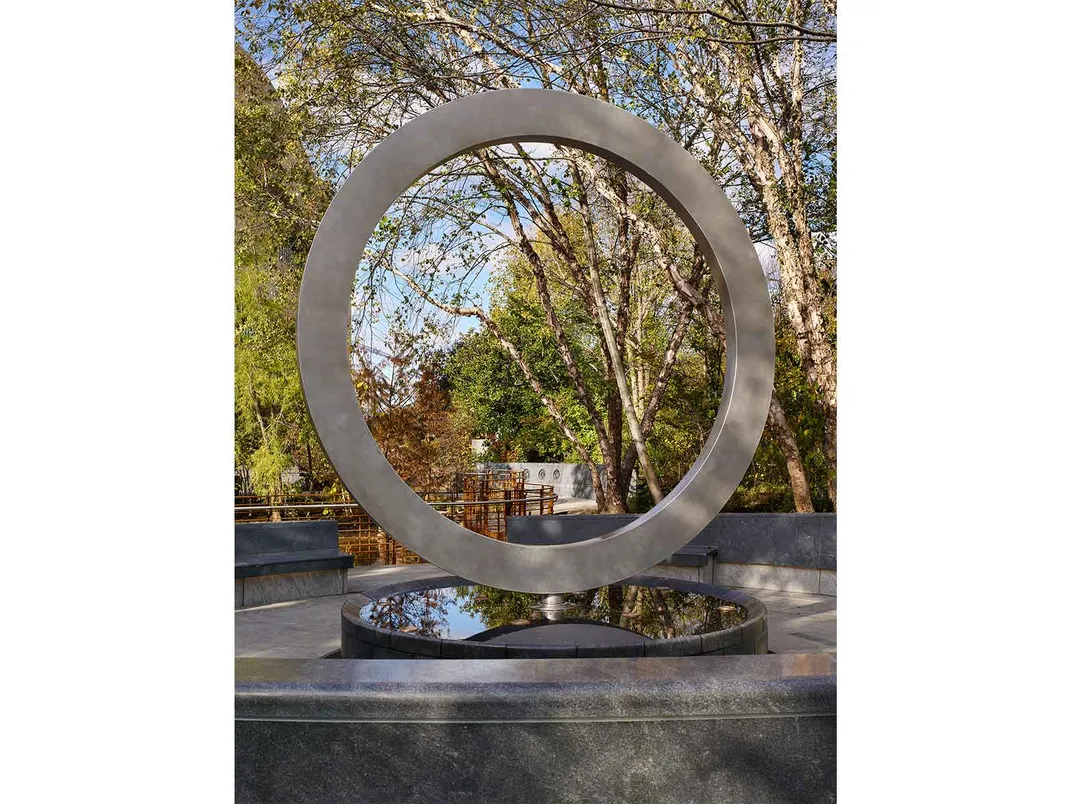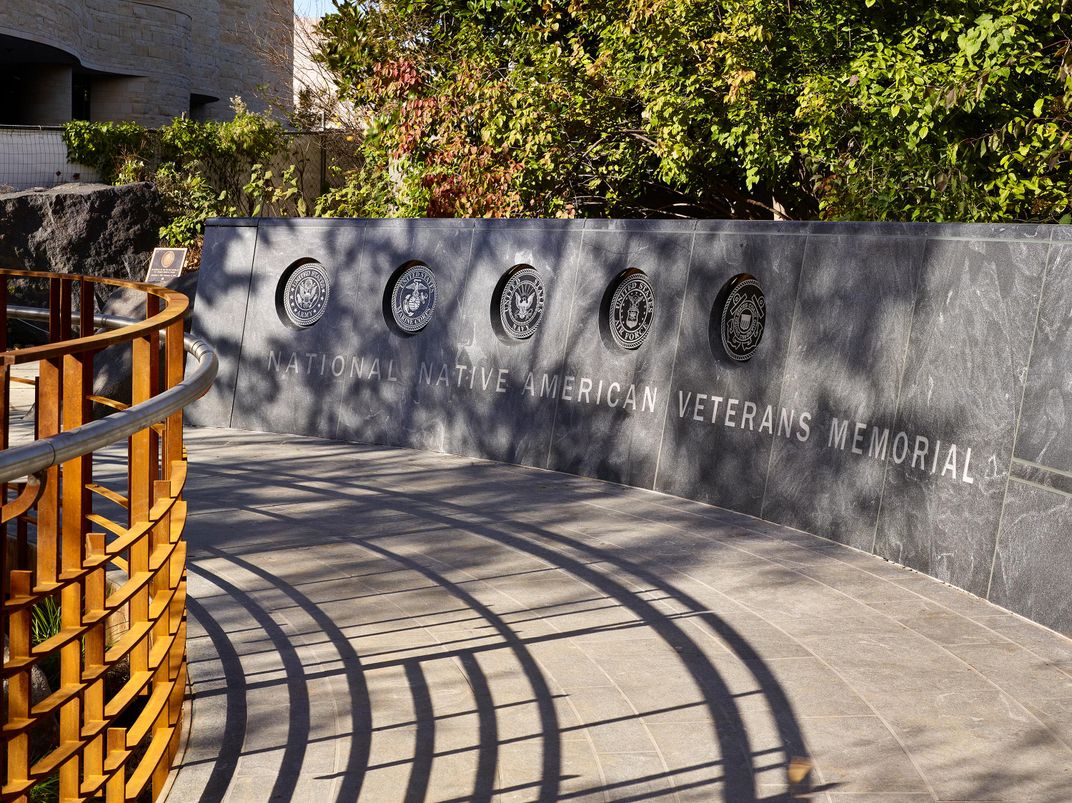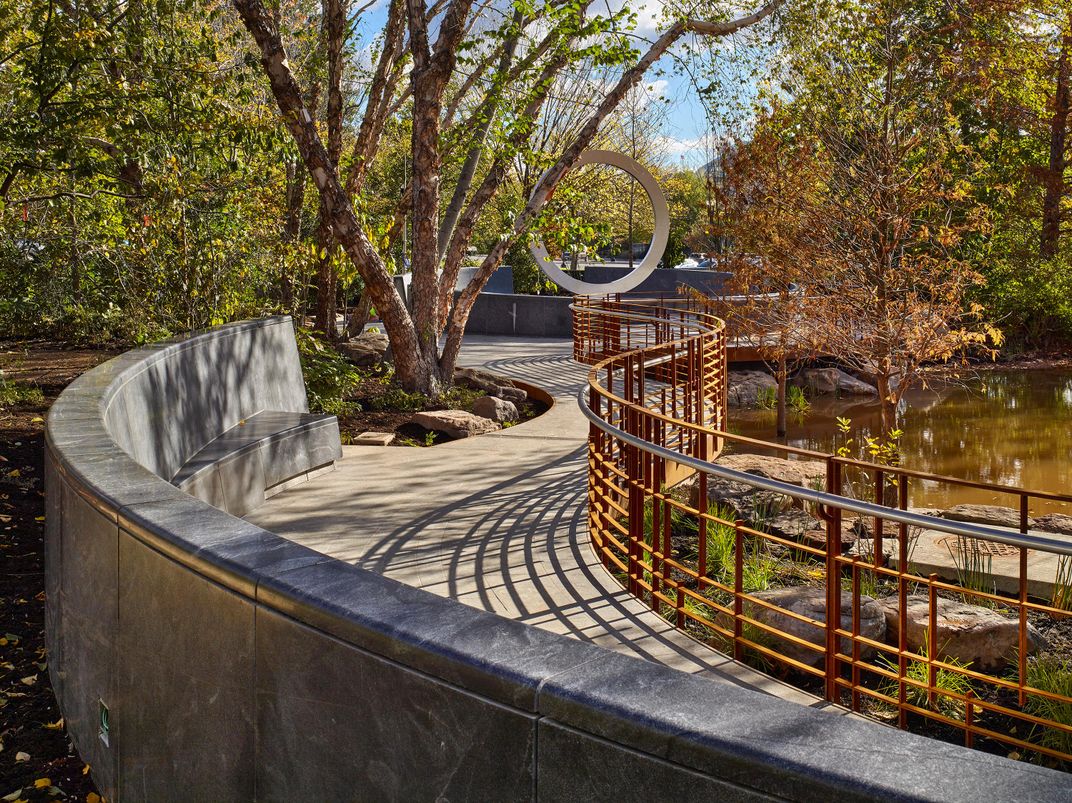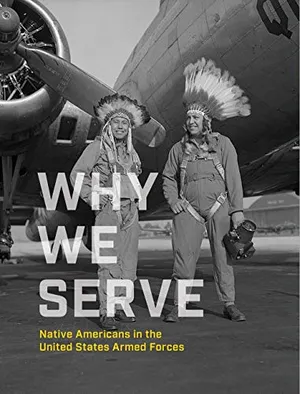Native American Veterans Receive a Place of Their Own to Reflect and to Heal
After two decades in the making, a veterans memorial is dedicated at the National Museum of the American Indian
/https://tf-cmsv2-smithsonianmag-media.s3.amazonaws.com/filer/8a/89/8a89d5e1-26d6-408e-8d3f-5f5859a29a4b/2020ak23_105.jpg)
On November 11, Veterans Day, the first national memorial dedicated solely to Native American veterans will be unveiled at the Smithsonian’s National Museum of the American Indian in Washington, D.C. The monument has been a little more than two decades in the making.
Due to the coronavirus pandemic, the unveiling will be virtual and won’t have the originally- planned pageantry. It will be marked by a short virtual message that will be posted to the museum’s website and its YouTube channel. But the unveiling will still be a triumphant and poignant moment for the hundreds of thousands of American Indians, Alaska Natives and Native Hawaiians who have served, or are currently serving in the military—and for their families and communities.
“Native Americans have always answered the call to serve, and this memorial is a fitting tribute to their patriotism and deep commitment to this country,” says the museum's director Kevin Gover.
“Native peoples have served in the United States military since the American Revolution and continue to serve at one of the highest rates per capita of any population group,” wrote Smithsonian Secretary Lonnie Bunch in the November issue of Smithsonian magazine. The Memorial “will recognize—for the first time on a national scale—the extraordinary service of these men and women and our shared obligation to honor this legacy,” he wrote. “I have always thought that you can tell an enormous amount about a nation by what it chooses to remember. This memorial and others to veterans, both on the National Mall and around the United States, are vital corners of our national memory.”
Harvey Pratt, who designed and created the National Native American Veterans Memorial, says he believes it will become a place of strength, power, healing and spirituality. Visitors will be coming “to pray for their family, for their loved ones that are in the military, they’re going to pray for ancestors that were in the military, they’re going to pray for their grandchildren [who] will be in the military,” says Pratt, a 79-year-old multimedia artist, Marine Corps veteran of Vietnam, and member of the Cheyenne and Arapaho Tribes of Oklahoma.
“They will come and make blessings and make sacrifices,” he says.
“Harvey Pratt created a space where Native people will be able to—whether in groups or individually—come into the space and if they want to they can do a ceremony to remember their own service or veterans from their community or their family,” says Rebecca Trautmann, the museum’s curator for the Memorial.
The Memorial—dominated by a 12-foot diameter stainless steel silver circle balanced on a 20-inch-high stone drum—is nestled in a woodlands environment just outside the museum’s main entrance. Visitors approach the Memorial on a meandering pathway and can enter a circular seating area from one of the four cardinal directions. There are four stainless steel vertical lances with bronze feathers and tips where visitors can tie prayer cloths. The seals of the five branches of the U.S. armed forces are on a wall nearby.
Why We Serve: Native Americans in the United States Armed Forces
Why We Serve commemorates the 2020 opening of the National Native American Veterans Memorial at the Smithsonian's National Museum of the American Indian, the first landmark in Washington, D.C., to recognize the bravery and sacrifice of Native veterans. The history of Native military service dates to colonial times, and today, they serve at one of the highest rates of any ethnic group.
Water flows continuously from the drum’s center and the museum anticipates lighting a flame at the base of the circle on occasions like Veteran’s Day, says Trautmann.
“The trees, the water, the sounds of birds and insects, and the wind going through the trees should help separate the memorial from the noise of the city,” she says. Its location will also “make it a quieter and more contemplative experience,” Trautmann says.
When the museum put out the original call for designs in 2017, the artists were charged with coming up with a memorial that would appeal to all native veterans, men and women, and all branches of the military. “Probably one of the biggest challenges of creating this memorial was finding a design that would be truly inclusive of all these different communities, individuals and traditions,” says Trautmann.
Once Congress finally authorized the building of the Memorial in 2013—after having first considered it in 1994—the museum put together an advisory committee made up of Native American veterans, tribal leaders and family members. That committee met with some 1,200 people in 16 states and Washington, D.C. over an 18-month period. “We really wanted to hear from Native veterans, their families, communities and tribal leaders what their experience of service has been and what they wanted the experience of visiting this Memorial to be—what was the story that the Memorial needed to tell and what are the values it should embody,” says Trautmann.
On Veteran’s Day in 2017, the museum put out an international call for designs. More than 100 proposals were submitted. The jurors announced in June 2018 that they’d unanimously selected Pratt’s design from among the five finalists. “As a universally respected symbol among Native cultures, the circle is an ideal foundation for a timeless and powerful memorial,” the jury wrote in a 2018 report appraising the finalists. “For something so simple, it is quite moving,” they said.
Pratt says the idea came to him in a dream. A circle is not only timeless—with no beginning and end—but it is important to all Native cultures, he says. “It’s the cycle of life, it’s the cycle of the seasons, it’s the sun and the moon, it’s the earth, it’s kivas, it’s tipis, dance circles,” says Pratt.
“Harvey likes to talk about this stainless steel circle as being the hole in the sky where the creator lives,” Trautmann says. The wind will carry prayers skyward through that opening, she says.
The $15 million project was funded from private contributions and not as a part of the Federal appropriation—$8 million went to construction, $4 million is for programming and outreach, and $3 million is for the ongoing care of the Memorial, says Trautmann.
Native American tribes and entities are the largest—and the majority of—the 85 or so contributors. Top donors include the Cheyenne and Arapaho Tribes, Chickasaw Nation, Margaret A. Cargill Philanthropies, Poarch Band of Creek Indians, San Manuel Band of Mission Indians, and Shakopee Mdewakanton Sioux Community. Other sponsors include Arctic Slope Regional Corporation, Calista Corporation, and Doyon, Limited, all of which are Alaska Native corporations. The Oklahoma State Bureau of Investigation Employees and Supporters also contributed, as Pratt is a retired forensic artist and a retired investigator for the Oklahoma State Bureau of Investigation.
Many tribes were planning to bring their veterans to Washington for the Memorial’s dedication. “We’re looking forward to seeing many of them next year when it’s safe for us to gather again,” says Trautmann.
In the meantime, those interested in Native American participation in military service can view the related exhibition, "Why We Serve" online or at the museum. The show, which opens November 11, details the 250-year history of Native American service in the U.S. military, and tells personal stories of Native veterans. The show is complemented by the companion guide from Smithsonian Books, Why We Serve: Native Americans in the United States Armed Forces; the 240-page volume is a deep dive into the history of Native service.
Trautmann expects that once it’s safe to do so, tribes will bring veterans and warriors groups to see the Memorial, and that Native-specific Honor Flights will make it an important stop. “It will be really exciting to see how it’s received and how it becomes part of that pilgrimage to Washington,” she says.
Harvey says he hopes it will be a destination for Native and non-Native veterans alike. “We welcome all veterans to come there and to pray and to feel good and to be healed,” he says.
Trautmann says it is a living, breathing Memorial, not just a place to stand and look. Pratt agrees. “It’s not a place to walk by, it’s a place that you have to go,” he says.
A Note to our Readers
Smithsonian magazine participates in affiliate link advertising programs. If you purchase an item through these links, we receive a commission.
/https://tf-cmsv2-smithsonianmag-media.s3.amazonaws.com/accounts/headshot/AliciaAult_1.png)




/https://tf-cmsv2-smithsonianmag-media.s3.amazonaws.com/accounts/headshot/AliciaAult_1.png)